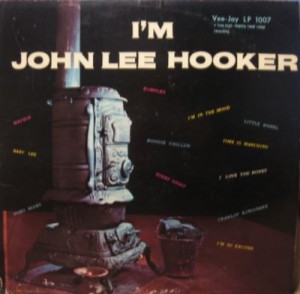2. Listening to the Blues
Bob Wilson gave me the blues. We were probably both in junior high (1955-1957), though it could have been earlier. His father and my father were both science professors at Kansas University in Lawrence, so we had probably met before we were junior high classmates. The blues have been characterized as “the Devil’s music” by religious fundamentalists, but it’s a genre that has cast a spell on me since I discovered it as a teenager.
Wilson became a lifelong friend and I was continually amazed at the depth and breadth of his musical interests and knowledge. It’s possible that I’d heard blues before Wilson, but he was the one who introduced me to the early country blues players. He gave me a 2-LP compilation by Samuel B. Charters called The Rural Blues (RBF Records, 1960). It included examples of such musicians as Sleepy John Estes, Robert Johnson, Blind Lemon Jefferson, Blind Willie Johnson, Lightnin’ Hopkins, Furry Lewis, Blind Willie McTell, Bukka White, and others whom I would never have heard in Kansas in the Fifties even in a college town. Robert Johnson and Lightnin’ Hopkins eventually became favorites.
My mother loved the early rock ‘n’ roll singers such as Chuck Berry, Bill Haley and the Comets and, above all, Elvis Presley. She drove Wilson and me to some of disk jockey Alan Freed’s (1921-1965) rock ‘n’ roll concerts in Kansas City before we were old enough to drive. I don’t remember which musicians we saw, but Chuck Berry and Bill Haley were probably among them.
I also remember that Mother had a book of sheet music of boogie-woogie, a percussive style of piano-based blues.When I asked her about it in 2009, she didn’t remember that she ever played the music. Whether she did or not, she could have had blues or blues-related records that I heard.
One of the first blues records I recall listening to at home was by John Lee Hooker (August 22, 1917 – June 21, 2001), who has been a favorite ever since. I don’t know what became of the album, but I’m almost certain it was I’m John Lee Hooker (Vee Jay, 1959), solo recordings (1955-1959) of him singing and playing electric guitar accompanied only by his foot-tapping. I loved his deep resonant voice and the haunting power of his Epiphone guitar.
Another early blues hero was Muddy Waters (McKinley Morganfield, April 4, 1913 – April 30, 1983), considered “the Father of Chicago blues” and probably the greatest player of that style. The Rock and Roll Hall of Fame listed four songs of his in the “The Songs that Shaped Rock and Roll”: “Rollin’ Stone” (1950), “Hoochie Coochie Man” (1954), “Mannish Boy” (1955) and “Got My Mojo Working” (1957). Both the British rock group and the American music magazine took their names from Muddy’s song. Like Hooker, he had a powerful and wonderfully resonant voice, but could also make his Fender Telecaster guitar sing, especially when playing slide.
From August, 1966 to March, 1970, I lived near Palo Alto, California while I went to graduate school at Stanford. This was an exciting time in rock ‘n’ roll history and I am grateful that I was “on the scene” when so much was happening on the West Coast. I first saw The Grateful Dead when they gave a free concert in a Palo Alto park some time in 1966 or 1967. I went to the Fillmore Auditorium in San Francisco to see many local and national bands (Janis Joplin with Big Brother and the Holding, The Jefferson Airplane, The Quicksilver Messenger Service, Country Joe and the Fish, Canned Heat, Jimi Hendrix, Paul Butterfield Blues Band). Many British rock musicians (John Mayall, Eric Clapton, The Rolling Stones, Peter Green and others) had discovered Mississippi Delta blues and had covered many songs by American blues greats when they were largely ignored in the U.S. That brought the blues to the attention of white audiences. It was common to include black American blues musicians on the bill at the Fillmore, for example. I don’t remember whom I might have seen, but it’s likely that I saw Muddy Waters, Albert King and others.
I first discovered Otis Taylor [born in Chicago in 1948] on February 20, 2004 when he was the opening act for the Malian musician Habib Koité at the Old Town School of Music in Chicago. Taylor played solo guitar and banjo and sang. I was enthralled. Since then I’ve bought all of Taylor’s CDs and have listened to them many, many times. I’ve been to hear him several times in Chicago and consider him the most exhilarating musician I know. He describes his take on the genre as “trance blues”[12] and the hypnotic background rhythms and droning effect of the music have the strongest appeal for me.
It’s difficult to put in words the attraction of a certain aesthetic experience. I’ve always enjoyed music and have found any music I connect with enlivening and energizing. At it’s best music is a spiritual activity and experience for both musician and listener. It allows our minds, hearts and spirits to communicate beyond words.
While I have not had an especially hard life, music in a minor key or in a mournful and melancholy mood appeals to me. For reasons I can’t account for, I find that the characteristic tonalities of Arabic and Oriental music speak to me very powerfully; they seem especially poignant and soul-piercing. Arabic-Islamic music was influential in certain areas of Africa and memories of this music remain in the tonalities of the blues.
